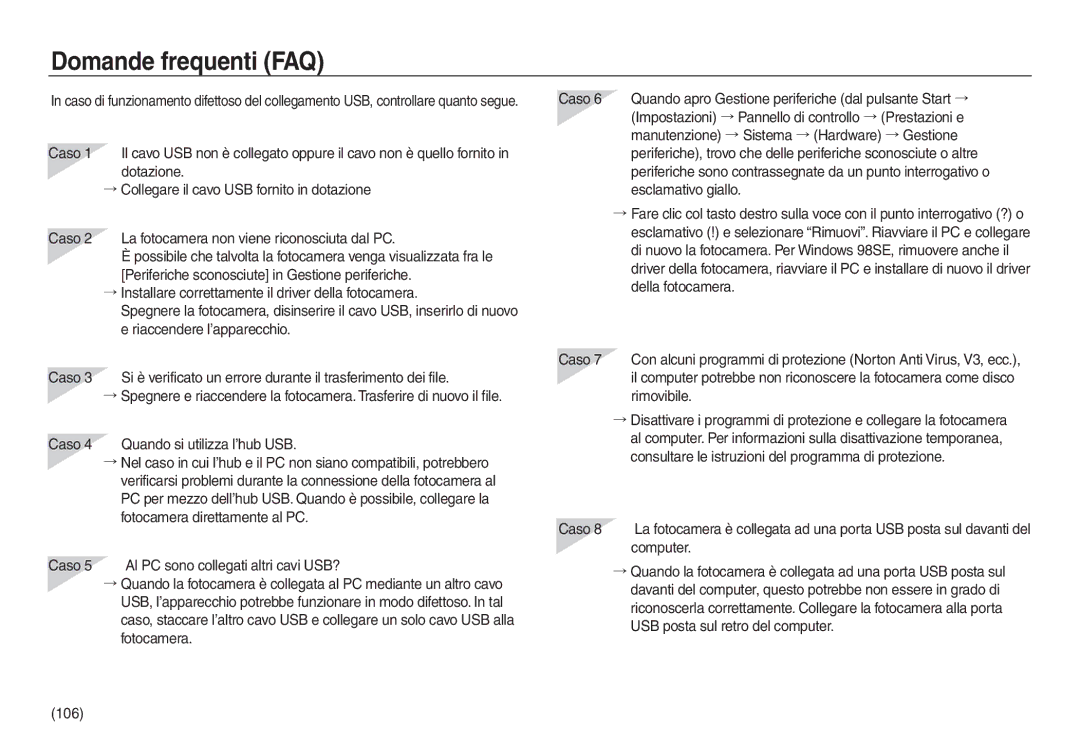Page
Aprire Windows Explorer e
Istruzioni
Imparare a conoscere la fotocamera
Avvertenza
Pericolo
Sommario
Attenzione
White Balance
Lingua
054 Nome File 062 Pulsante Miniatura / Ingrandimento
Software
103 Samsung Master 106 Domande frequenti FAQ
Cavo AV
Schema del sistema
Pulsante otturatore Altoparlante Flash
Identificazione dei componenti
Fronte e parte superiore
Pulsante modalità Riproduzione Stampa
Retro
USB/ AV
Parte inferiore
Pulsante a 5 funzioni
Piano
Scena
Primo Bambini
Testo
Collegamento ad una sorgente di alimentazione
Uso di un cavo CA
Come ricaricare la batteria SLB-0937 LED di caricamento
Inserire la scheda di memoria come illustrato in figura
Indicatore Batterie
Inserimento della scheda di memoria
Inserire la batteria come illustrato in figura
Istruzioni per l’uso della scheda di memoria
20FPS
Destra
Primo utilizzo della fotocamera
Impostazione della data, dell’ora e del tipo di data
Impostazione della lingua
ISO
Indicatore display LCD
Come utilizzare la modalità Program
Avvio della modalità di registrazione
Come utilizzare la modalità Auto
Come utilizzare la modalità Manuale
Uso della modalità ASR
Tramonto
Uso delle modalità Scena
Ritratto, Modalità di scena notturna
Dell’otturatore
Uso della registrazione successiva
Come utilizzare la modalità Filmato
Registrazione del filmato senza suoni
Filmato
Condizioni di oscurità
Elementi a cui prestare attenzione quando si scattano foto
Zoom Tele
Pulsante di Zoom W/ T
Pulsante Accensione
Pulsante Otturatore
Zoom digitale 5,0X Zoom Tele
Zoom ottico Digitale
Macro automatica
Info / Pulsante Su
Pulsante Macro / Giù
Mode
Mode Auto macro
Unità di misura cm Modalità
Programmata
Auto
Blocco della messa a fuoco Pulsante Flash / Sinistra
Flash
Tele
Della fotocamera entrerà in funzione
Indicatore modalità flash Icona
Display LCD viene visualizzato l’indicatore
Descrizione
Autoscatto / Pulsante Destra
Pulsante OK
Autoscatto / Pulsante Destra Pulsante Menu / OK
Selezionare la funzione Autoscatto
Selezione dell’autoscatto Da 10 SEC Pulsante Menu
Pulsante FR per il riconoscimento del volto
Pulsante EEffetto
Pulsante EEffetto Colore
Modifica della saturazione
Pulsante EEffetto Saturazione
Selezionare il menu Di Saturazione e
Premere il pulsante Fn
Gamma
Preimpostata
Pulsante dell’otturatore
Ripresa composita
Pulsante EEffetto FUN
Nuovo scatto della Risultato finale Seconda immagine
Prima del terzo scatto
Ritorno al secondo scatto
Cornice
Su/Giù
Tasto Fn
Uso del menu
Pulsante
L730
Dimensione
Qualità / Velocità fotogrammi
L830
Modalità Drive
Misurazione
ISO 80, 100, 200, 400, 800
Wise Shot
Uso della funzione Wise Shot
Fluoresc H
Auto WB
Luce Diurna
Nuvoloso
Stabilizzatore dell’inquadratura di un filmato
Compensazione dell’esposizione
TRAMONTO, Alba Scena Controluce
Uso del menu
Utilizzare i pulsanti SU e GIÙ per selezionare un sottomenu
Vocale
Contrasto
Nitidezza Area di messa a fuoco
Memo vocale Registrazione voce
Per sospendere la registrazione, premere il Pulsante Pausa
Registrazione voce Registrazione del filmato senza la voce
Alto Suono AV
Modalità scene
Menu Suono
Menu Modalità
Suono di avvio
Volume
Suono
Suono Beep
Menu Sottomenu
Menu Impostazione
Impostazione di data / ora / tipo di data
Menu Impostazioni
Nome file
Luminosità LCD
Stampigliatura della data di registrazione
Spia di messa a fuoco automatica
Immagine di avvio
Salva LCD
Anteprima
Spegnimento automatico
LCD della fotocamera
Selezione del tipo di uscita video
Collegamento a un monitor esterno
Esterno, l’immagine e il menu sul monitor LCD
Inizializzazione
Formattazione di una scheda di memoria
RIPRODUZIONE/PAUSA
Avvio della modalità Riproduzione
Riproduzione di un filmato
Playback di un’immagine fissa
Finestra di conferma Selezionare il sottomenu desiderato
Funzione cattura filmato Durante il taglio di un filmato
Premere il pulsante Pausa Nel
Estrazione
Per fermare la riproduzione premere il pulsante Menu/OK
SINISTRA/DESTRA
Visualizzazione miniature
Pulsante Miniatura / Ingrandimento
Visualizzato un messaggio
Pulsante Miniatura / Ingrandimento
X12.8 X12.4 X10.1 X8.0 X4.0
X12.0 X10.1 X8.0 X4.0
Pulsante Riproduzione / Pausa / Giù
Pulsante Info / Sù
Ritornare al display iniziale
Pulsante Elimina
Tasto Stampa
Pulsante Destra
Tipi di ridimensionamento dell’immagine L830
Pulsante EEffetto Ridimensiona
Ridimensiona
Orizzontale
Selezionare il menu premendo il tasto Sinistra/ Destra
Selezionare premendo sul pulsante SU/GIÙ
Pulsante EEffetto Colore Pulsante EEffetto Colore speciale
Filtro colore
Colore personalizzato
Máscara de cor
Pulsante W/T Per modificare la dimensione della parte
Pulsante EEffetto Editing delle immagini
Selezionare Fumetto
Fumetto
Preimpostare i riquadri di messa a fuoco
Sinistra/Destra
Immagine composite
Un menu Gamma
Premere OK per selezionare ancora un’immagine
※ Selezione di 2 scatti composite
Cornice
Con il pulsante
Adesivo
Selezionare l’
※ Le specifiche sono soggette a modifica senza preavviso
Sottomenu Menu secondario Pagina
4X6
Tipo
Presentazione
Avvio della presentazione
Selezione delle immagini
Avvia la presentazione
Impostazione della musica di sottofondo
Configurazione degli effetti per la presentazione
Impostazione dell’intervallo di riproduzione
Protezione delle immagini
Riproduci
Memo vocale
Visualizzare il messaggio di
Per cancellare le immagini
Eliminazione di immagini
Eliminare
Tutte le immagini ad eccezione dei File di filmati e vocali
Cui selezionare l’immagine
Immagine da Stampare
Pulsante di zoom W/T selezionare il numero di stampe
Le immagini archiviate
Copia su scheda
Archiviata nell’ultima cartella copiata
PictBridge
Ultimo nome di file memorizzato
Quando si seleziona il comando Serie del menu di
Menu PictBridge
PictBridge PictBridge Selezione delle immagini
PictBridge Reimposta
Inizializza le configurazioni modificate dall’utente
PictBridge Impostazioni di stampa
Page
Sul display LCD vengono visualizzate varie avvertenze
Indicatore di avvertenze
Manutenzione della fotocamera
La fotocamera non si accende
ᆞLa fotocamera viene utilizzata a basse temperature
ᆞBassa capacità della batteria → Inserire batterie nuove
Controllare quanto segue
Prima di rivolgersi a un centro di assistenza
Obiettivo
Specifiche
Monitor LCD
Messa a fuoco
Effetto colore
Esposizione
Flash
Nitidezza
Peso
Dimensioni LxHxP
Interfaccia
Alimentazione
Consigliato oltre 1 GB
Requisiti di sistema
PC con processore migliore del Pentium II 450MHz
Informazioni sul software
Impostazione del software applicativo
Impostazione del software applicativo
Avvio della modalità PC
Avvio della modalità PC
Avvio della modalità PC
Staccare il cavo USB 101
Rimozione del disco rimovibile
Utilizzo del driver USB per MAC
Impostazione del driver USB per MAC
103
Samsung Master
Help Guida
Adjust
Vedere il menu Help Guida
Media Video e ASF Windows Media File
Add Media
Domande frequenti FAQ
Quando il filmato non viene riprodotto nel PC
Installazione di un codec per il sistema operativo Mac
Corretto smaltimento del prodotto
109

